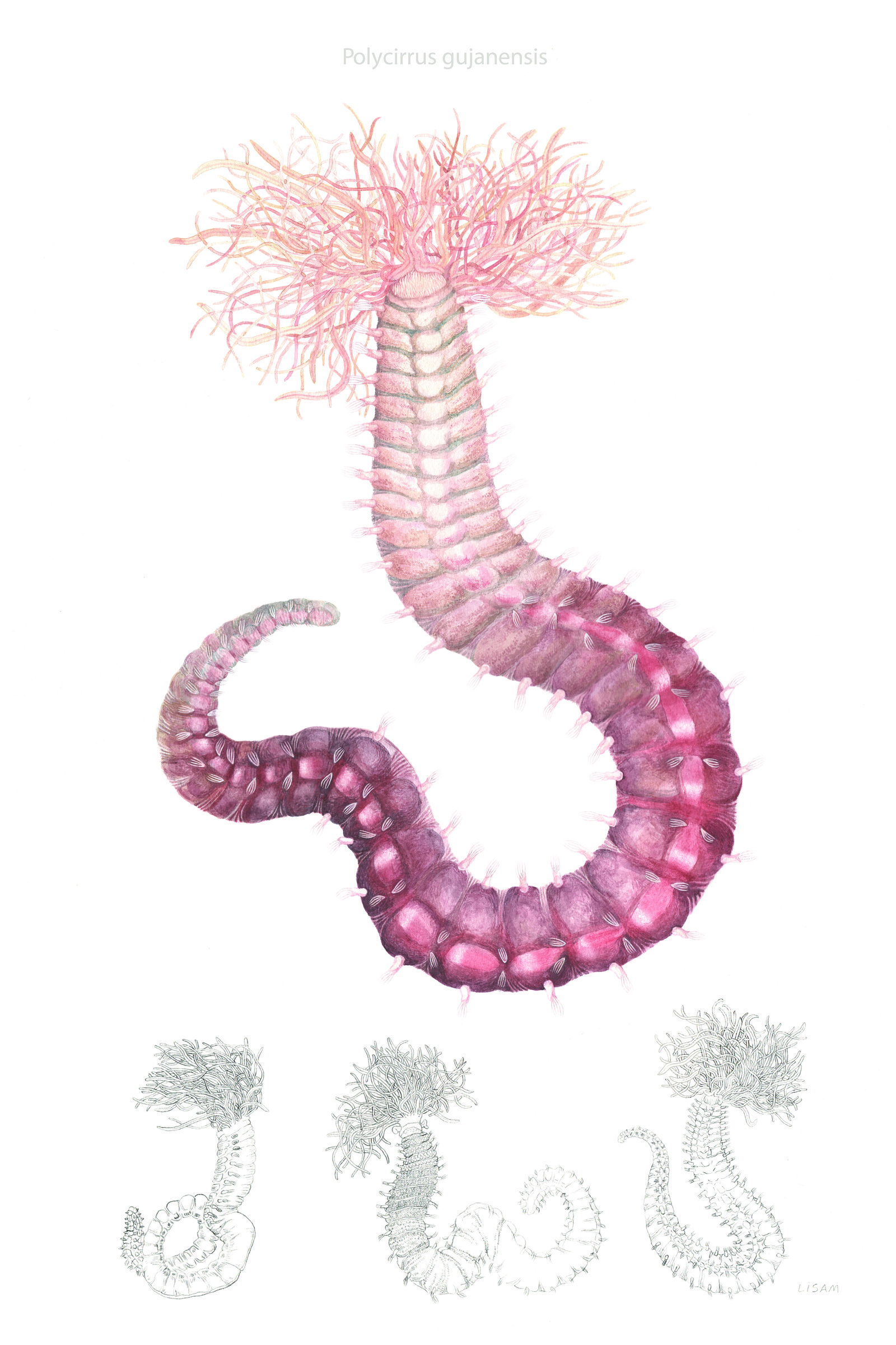To open a can of worms: the complications of hidden biodiversity
We are describing our biodiversity at a higher rate than we can teach the next generation of taxonomists – how can we tackle this problem? Dr Pat Hutchings in Australia and Dr Nicolas Lavesque in France show us how, in their experiences of describing Spaghetti worms!
For almost 100 years, one new species of terebellid worms (aka Spaghetti worms) was described from France. That was, until 3 years ago – during these past years, 31 new species have been described and several species previously reported were found to be misidentifications. This takes the tally of new terebellid worm species to a whopping 58, that we know of.

Example of a terebellid worm, Polycirrus gujanensis.
Image: Lisa Miroglio© Lisa Miroglio
So why is this? For decades, people were referencing the well-illustrated work, Faune de France by Fauvel (1927). Many of the species listed by Fauvel were described in the late 1800’s and were often poorly illustrated, referencing no extant type material and often listed vague type localities such as the “Mediterranean”. This meant that over time, these names were used widely throughout Europe and even in Australia, and their descriptions morphed into one encompassing several species. In addition, there has been a lack of active polychaete taxonomists in France, despite several French famous early taxonomists.
In 2016, the French National Centre for Scientific Research (CNRS) organised a taxonomic course in Caen and invited Dr Pat Hutchings to provide lectures and practicals (with freshly collected material) on terebellids for a week. The audience was composed of graduate students, early career researchers and established ecologists. Nicolas Lavesque was part of this cohort – Pat made such an impression, that Nicolas decided he wanted to undertake a PhD on the systematics of terebellids! Nicolas also requested Pat to be his supervisor and planned on spending time in Sydney for further research. And in October 2019, Nicolas arrived in Sydney to spend 9 months at the Australian Museum! Although it was cut short by COVID-19 (Nicolas only spent 7 months at the AM), Nicolas and Pat were able to completely revise the French terebellid fauna as well as describe some new species!

Dr Pat Hutchings and Dr Nicolas Lavesque.
Image: Dr Pat Hutchings and Dr Nicolas Lavesque© Dr Pat Hutchings and Dr Nicolas Lavesque
During Nicolas’ time at the AM, Nicolas and Pat were fortunate to be able to work on freshly collected material, so both molecular and morphology characteristics were available to describe the new species and expand descriptions of previously known species. The recent study also highlighted that several species previously recorded by Fauvel represent suites of species which can be referred to as cosmopolitan species. While this study resolved their nomenclature issues of the French material, records from other parts of the world require far more work to resolve their true identity.
So, what are the consequences of this hidden biodiversity? First of all, misidentifications have a strong impact on ecological studies. Indeed, pseudo-cryptic species can show very different ecological or functional traits. They can be distinguished by their reproduction biology, their feeding strategy, their ecological sensibility or their preferences for different habitats. Incorrect identifications can also have impacts if the considered species is actually an exotic one. For example, this study revealed that one of the terebellid species, Thelepus japonicus, is actually an introduced species, reported for the first time in Europe. Its presence in Arcachon Bay and in Normandy is linked to oyster farming with a probable introduction from Japan via oyster transfers. For decades, this species was confused with a French species: T. setosus. Finally knowing the exact number of species within a region is essential in a Global Change point of view and to correctly evaluate the loss of species in the current biodiversity crisis.
![[Image of Thelepus japonicus]](https://media.australian.museum/media/dd/images/Fig3_Thelepus_japonicus.87ecdb0.width-1600.5ccfa40.jpg)
Image of Thelepus japonicus
Image: Dr Nicolas Lavesque© Dr Nicolas Lavesque
This story almost certainly is relevant to all the other polychaete families present in France described by Fauvel, but Pat and Nicolas strongly believe such a scenario is true for many parts of the world and a recent paper in press on the polychaete fauna of South Africa reveals similar patterns where Day (1967) described the fauna and little has been done since then.
Finally, and perhaps most importantly, passing on of the accumulated knowledge of a senior researcher to the next generation of researchers is essential in developing fields in taxonomy – and this can be done across continents. Such collaborations can also lead to long term research projects for future generations!
Dr Pat Hutchings, Senior Fellow, Marine Invertebrates, Australian Museum
Dr Nicolas Lavesque, Research Engineer, French National Centre for Scientific Research (CNRS)
More information:
- Lavesque N., Daffe G., Londoño-Mesa M.H., Hutchings P. (2021) Revision of the French Terebellidae sensu stricto (Annelida, Terebelliformia), with descriptions of nine species. Zootaxa 5038, 1-63. DOI: 10.11646/zootaxa.5038.1.1
- Lavesque N., Hutchings P., Daffe G., Londoño-Mesa M.H. (2020) Revision of the French Polycirridae (Annelida, Terebelliformia), with descriptions of eight species. Zootaxa 4869 (2): 151-186. DOI: 10.11646/zootaxa.4869.2.1
- Lavesque N., Hutchings P., Londoño-Mesa M.H., Nogueira J.M.N.N., Daffe G., Nygren A., Blanchet H., Bonifácio P., Broudin C., Dauvin J.C., Droual G., Gouillieux B., Grall J., Guyonnet B., Houbin C., Humbert S., Janson A.L., Jourde J., Labrune C., Lamarque B., Latry L., Le Garrec V., Pelaprat C., Pézy J.P., Sauriau P.G., de Montaudouin X. (2021) The “Spaghetti Project”: the final identification guide to European Terebellidae (sensu lato) (Annelida, Terebelliformia). European Journal of Taxonomy 782: 108–156. DOI: 10.5852/ejt.2021.782.1593
- Lavesque N., Hutchings P., Daffe G., Nygren A., Londoño-Mesa M.H. (2019). A revision of the French Trichobranchidae (Polychaeta), with descriptions of nine new species. Zootaxa 4664(2): 151-190. DOI: https://doi.org/10.11646/zootaxa.4664.2.1
- Lavesque N., Londoño-Mesa M.H., Daffe G., Hutchings P. (2020). A revision of the French Telothelepodidae and Thelepodidae (Annelida, Terebelliformia), with descriptions of three species and first European record of a non-indigenous species. Zootaxa 4810 (2) 305-327. DOI: 10.11646/zootaxa.4810.2.4










